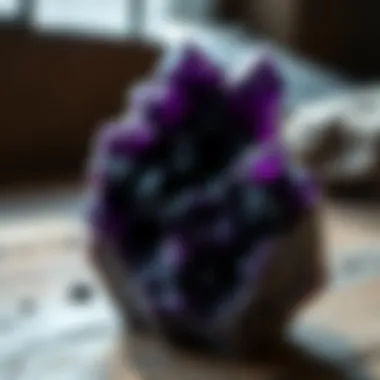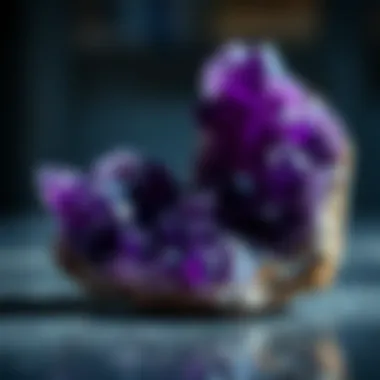Exploring Dark Purple Crystals: Properties and Uses


Intro
The world of dark purple crystals beckons with a kind of mystique that seems drawn from realms both earthly and ethereal. These striking formations, ranging from deep amethyst to mesmerizing charoite, not only captivate the eye but also encapsulate a wealth of knowledge and potential in their myriad facets. Each crystal, with its unique histories and characteristics, is a small chapter in the story of our planet, bridging the geological and the metaphysical.
Whether you're a seasoned rock and fossil collector, a budding geology student, or simply someone enchanted by the natural wonders around us, understanding these dark purple gems opens the door to a deeper appreciation of their beauty and utility. This guide aims to illuminate the paths of identification, collection, preservation, and the geological processes at work, so that no stone is left unturned.
Rock and Fossil Identification
Identifying dark purple crystals requires an eye for detail and a certain sense of adventure. Each crystal boasts its own set of characteristics, which makes this endeavor both educational and enjoyable.
Types of Rocks and Fossils
Dark purple crystals can often be found in various rock formations. Common examples include:
- Amethyst: Renowned for its vibrant purple hues, amethyst is a variety of quartz, found in geodes and volcanic rocks.
- Charoite: This rare mineral exhibits swirling patterns and is often associated with metamorphic rock formations in Siberia.
- Sugilite: A lesser-known gem that displays striking purple color with potential streaks of black or blue, often found in manganese-rich deposits.
Characteristics to Look For
As you examine these crystals, focus on distinct features:
- Color Variance: Not all purple hues are created equal, so note the range from pale lavender to deep violet.
- Clarity: Crystals can be transparent, translucent, or opaque. A gem’s lustrous quality often reveals its authenticity.
- Striations and Inclusions: Look for lines or internal flaws. They can hint at the crystallization process and even the environment they formed in.
Tools for Identification
To assist in identifying your crystals, consider employing:
- Hand Lens or Loupe: This magnifying tool helps you discern small details that are hard to see with a naked eye.
- Hardness Test Kit: This can determine the mineral’s hardness based on the Mohs scale, allowing for more precise identification.
- Field Guidebooks: Handy references can provide visuals and descriptions to help make informed comparisons.
"Understanding the basics of identification equips you to better appreciate how dark purple crystals fit into the complex tapestry of earth's geology."
As one embarks on the journey of rock and fossil identification, patience and curiosity serve as invaluable companions. The fluorescence and shimmer of dark purple gems hold secrets waiting to be uncovered.
Prelims to Dark Purple Crystals
Dark purple crystals possess a uniqueness that goes beyond their striking appearance. They hold a significant place in the realms of geology, metaphysics, and even history. Understanding these crystals can offer valuable insights not just for collectors, but for anyone intrigued by Earth’s natural wonders. Their vibrant hues often capture the attention of both novice rock hounds and seasoned geologists alike, creating a bridge between aesthetics and science.
Understanding Crystals
Crystals are solid materials where atoms are arranged in an orderly repeating pattern. This structured formation leads to various physical properties that define a crystal's identity. Dark purple crystals, such as amethyst and purple fluorite, are formed through different geological processes, including volcanic activity or evaporation of mineral-rich water.
For collectors, understanding the characteristics of these crystals is essential. Each type not only tells its own story of origin but also provides information about its potential uses and value. Whether you’re looking to add to a collection or simply appreciate their beauty, knowing about the geological backdrop of these specimens can enrich your experience.
Some common properties to consider include hardness, which is measured on the Mohs scale, and luster, the way light interacts with the surface of the crystal. For example, amethyst typically scores a 7 on the Mohs scale, making it relatively durable, while also showcasing a vitreous luster that can catch anyone's eye.
Significance of Color in Crystals
Color plays a pivotal role in how crystals are perceived and valued. In the world of gemstones, dark purple hues are often associated with luxury, mystery, and deep spiritual connection. This color is not merely visual; it is deeply intertwined with the crystal’s formation and composition. The presence of iron and manganese, for instance, can create stunning shades of violet and purple in quartz crystals.
Dark purple crystals are often linked to various meanings and uses in multiple culture. Historically, they’ve been tied to royalty, owing to their rare color. Spiritual practices often attribute healing properties to these crystals, claiming they can help balance the mind and spirit.


"The deeper the color, the more powerful the stone is believed to be". This aphorism, though simplistic, reflects a widespread belief among collectors and enthusiasts.
By understanding color, collectors are equipped to evaluate the quality and significance of their specimens effectively. The subtle gradation between a rich purple and a faded hue can influence both market value and metaphysical beliefs.
In sum, delving into dark purple crystals opens a treasure chest of knowledge and appreciation. From recognizing their origins and properties to unpacking the cultural significance of their hues, each layer offers the opportunity for profound engagement with the earth's magnificent gifts.
Common Dark Purple Crystals
Exploring common dark purple crystals is more than just identifying their names and aesthetics; it's about understanding their unique properties and uses. Each of these crystals possesses specific features that set them apart, and they often embody rich histories and cultural significance. For enthusiasts, collectors, and even casual admirers, familiarity with these distinguished gems unlocks new avenues for appreciation and application.
Amethyst
Amethyst stands as perhaps the most revered dark purple crystal, cherished for its striking color and considerable range of purples. It's not just a pretty face in the realm of gemstones; amethyst has a hardness of 7 on the Mohs scale, making it relatively resilient to scratches. Historically, amethyst has been associated with clarity of mind and spiritual growth. Many believe it guards against negativity, facilitating an environment for peace and tranquility. Its properties make it a popular choice for jewelry and meditation practices.
Purple Fluorite
Purple fluorite is another notable contender in the lineup of dark purple crystals. This crystal, known for its vibrant purple hues often mixed with green or blue, embodies a soft, calming energy. Classified as a softer mineral with a hardness of 4, caution is recommended when handling. It's said to enhance mental clarity and help balance emotional well-being, thus contributing significantly to intuitive pursuits and focus. This stone's utility extends into practical realms as well, frequently used in educational settings for its reputed ability to aid in concentration and memory.
Lepidolite
Lepidolite, with its captivating lilac shades, is a lithium-rich mica that not only pleases the eye but also the spirit. Its delicate coloration often gives it an almost fibrous appearance. Characterized by a hardness of about 2.5 to 3, this mineral is relatively soft, which warrants careful handling. Lepidolite is known for promoting emotional balance and easing anxiety, making it a favored choice among those seeking solace and comfort during tumultuous times. From jewelry to healing practices, it holds a unique spot in the hearts of crystal enthusiasts.
Iolite
Iolite intrigues many with its deep blue-purple hues that shift in tone depending on the angle of the light—this quality is often referred to as pleochroism. Harder than the previous crystals at about 7 to 7.5 on the Mohs scale, iolite finds its way into both decorative pieces and functional jewelry. Historically, it is known as the 'Vikings' Compass,' believed to assist in navigation, especially during cloudy weather. Many collectors also value iolite for its links to inner vision and emotional clarity, making it a prized addition to any serious collection.
"Each of these crystals carries its own story, steeped in myth, significance, and practical application. They serve as more than just decorative pieces; they are companions in our quest for tranquility and understanding."
By grasping the nuances of these common dark purple crystals, collectors and enthusiasts can deepen their appreciation for the natural beauty and functionality these gems offer. Each holds a unique significance, enriching our experiences as we explore the fascinating world of geology and spirituality.
Geological Formation of Dark Purple Crystals
Understanding the geological formation of dark purple crystals offers a critical glimpse into their origins and how the Earth’s processes sculpt these remarkable formations. Each crystal carries a tale that intertwines nature's processes with the fascinating mineral composition present in different environments. Knowledge of how these crystals are formed not only enhances one’s appreciation but also guides collectors in differentiating between genuine specimens and imitations.
Mineral Composition
The mineral makeup of a crystal is crucial to both its appearance and its properties. Dark purple crystals predominantly consist of minerals like amethyst, which is a variety of quartz, and others such as fluorite and iolite. Each mineral comes with its own unique blend of elements which contributes to color, clarity, and hardness. For instance, iron impurities within amethyst give it a rich purple hue, while the presence of manganese can enhance its vibrance. Understanding these compositions enables collectors to make informed decisions when adding these gems to their collections.
Formation Processes
The processes that lead to the formation of dark purple crystals are diverse and intricate. From the depths of the Earth to the forces of nature at work, these formations result from several key geological activities.
Metamorphic Processes
In metamorphic environments, existing rocks undergo transformation due to heat and pressure, giving rise to dark purple crystals. The ability to withstand extreme conditions makes these formations particularly strong, characterized by their distinctive structure. Metamorphism is central in forming crystals like lepidolite, which not only showcases a rich purple color but also contains lithium, adding to its appeal for collectors and geologists alike. A key advantage of this process is its ability to create crystals that reflect the geological history of the area, showcasing the dynamic changes of the Earth over time.
Volcanic Activity
Volcanic activity is another major contributor to the formation of dark purple crystals. As magma cools and solidifies, it can form unique volcanic minerals such as fluorite. One interesting feature of volcanic activity is its rapid cooling process, which can create striking variations in crystal shapes and colors. This rapid solidification can result in crystals that are rich in inclusions, making each specimen unique. The advantage of sourcing crystals formed this way is the potential for finding stones that exhibit interesting textures and patterns absent in slower-formed counterparts.
Hydrothermal Deposits


Hydrothermal deposits occur when mineral-rich water percolates through the Earth’s crust, leading to the crystallization of minerals in cooler zones. This process is particularly vital for forming dark purple fluorite. One interesting characteristic of hydrothermal deposits is their high purity levels, which often result in vivid colors and clear clarity. Notably, hydrothermal formations can produce larger crystals compared to other processes, making them highly sought after in collections. However, these deposits can be quite localized; hence, knowing where to look can save collectors time and effort.
In summary, the geological formation of dark purple crystals encompasses an array of processes—each providing a different narrative and contributing to these captivating minerals' final form. Collectors and enthusiasts who appreciate these origins will find their connection to their specimens deepen, transforming simple admiration into a passionate pursuit.
"Crystals hold the history of their formation in their very structure—each one a testament to the Earth's journey through time."
Physical Properties of Dark Purple Crystals
Understanding the physical properties of dark purple crystals is crucial for rock and fossil collectors as it helps in identifying, authenticating, and appreciating these unique geological specimens. These properties also play a significant role in determining how the crystals are utilized in jewelry, metaphysical practices, and in various industrial applications.
Hardness and Luster
When it comes to crystals, the Mohs scale of hardness is often the go-to gauge for assessing their durability. Dark purple crystals typically exhibit a range of hardness levels, depending on their mineral composition. For instance, Amethyst, a quartz variant, scores a solid 7 on the Mohs scale, making it sufficiently resistant to scratches and a popular choice for jewelry.
In contrast, Lepidolite, while beautiful and purplish, is softer, showcasing a hardness of about 2.5 to 4 on the scale. This means it’s more fragile and requires careful handling.
The luster of these crystals can vary from vitreous to pearly. For example, Iolite reveals a vitreous luster when polished, reflecting light beautifully and enhancing its appeal. The luster influences not just aesthetics but practical considerations, as a higher luster can indicate better quality. Thus, when purchasing or collecting these crystals, both hardness and luster should be evaluated. If you find a piece that shines like a new penny, it’s generally a keeper, but if it’s dull and easily scratched, it may not be worth the investment.
"A crystal’s luster can speak volumes; it tells stories about its quality, its journey through the earth, and its potential value to collectors."
Crystal Structure
The crystalline structure of dark purple crystals also carries significant weight, offering insight into their formation and characteristics. Dark purple crystals are typically formed in a specific pattern, which defines their overall shape and internal symmetry. For instance, Amethyst forms in a hexagonal structure, leading to its signature pointed, prismatic appearance.
In contrast, Fluorite, which can also be found in dark purple hues, adopts a cubic structure. This cubic system can create octahedral crystals that are visually striking and show interesting optical properties. The unique arrangements of atoms within these crystals influence how they grow and interact with light.
For collectors, understanding the crystal structure goes beyond aesthetic appreciation; it aids in identification. Knowledge of crystallography can help distinguish between genuine dark purple specimens and imitations. Moreover, certain crystal structures resonate with specific metaphysical properties, appealing to enthusiasts who believe in the energies of each mineral.
To summarize the interplay of hardness, luster, and structure, collectors should appreciate not only the surface beauty of dark purple crystals but also the physical traits that contribute to their allure and practical considerations. As one delves deeper into these elements, the significance of each crystal becomes ever more profound, enriching the overall collecting experience.
Metaphysical Properties of Dark Purple Crystals
Dark purple crystals hold a special place in the realm of metaphysics, often associated with higher consciousness, spiritual enlightenment, and emotional healing. This section is crucial as it elucidates the intrinsic benefits and considerations that come with harnessing the metaphysical properties of these stunning geological formations, thus enriching the understanding for collectors and enthusiasts alike.
Healing Properties
The healing properties of dark purple crystals are widely recognized and can have profound effects on both physical and emotional well-being. Crystals like Amethyst are frequently used for their calming energies, believed to soothe stress and anxiety. Here’s a detailed look at their healing influences:
- Stress Relief: Many people use dark purple crystals to alleviate tension and promote relaxation. Amethyst, for instance, is noted for its ability to calm the mind and reduce overthinking.
- Emotional Healing: These crystals are considered powerful allies for emotional struggles. They can assist in releasing negative emotions and fostering resilience against distressing thoughts. Lepidolite, known for its lithium content, is favored for balancing moods and aiding in overcoming grief.
- Strengthening Intuition: Collectors often cherish dark purple stones for their reputed ability to enhance intuition and psychic abilities. Iolite is known to enhance inner vision and provide insight, making it a particularly valued stone for those on a spiritual journey.
Caring for the healing properties of these crystals involves regular cleansing and recharging to ensure that they continue to radiate their beneficial energies.
Spiritual Significance
The spiritual significance of dark purple crystals extends far beyond their aesthetic appeal. Cultures throughout history have revered these crystals for their mystical attributes.
- Connection to Higher Realms: Dark purple crystals are often linked to the crown chakra. This association helps in connecting individuals to higher planes of existence and spiritual awareness. Many practitioners believe that meditating with Amethyst facilitates communication with spiritual guides.
- Protection and Purification: These gemstones are also viewed as protectors, providing a shield against negative energies. Collectors often keep them around living spaces or personal altars to enhance positive vibrations.
- Symbol of Royalty and Power: Historically, the deep purple color has been associated with power and nobility, making these crystals a symbol of wealth and prestige in many cultures. This significance continues to resonate today, where having dark purple crystals can feel empowering.
"Dark purple crystals act as a bridge, allowing individuals to grasp their hidden potential and embark on a journey of self-discovery."
The metaphysical properties of dark purple crystals are indeed profound, serving not only as beautiful additions to collections but also as significant tools for healing and spiritual growth. This multifaceted nature makes them invaluable to collectors and enthusiasts, offering continuous learning and exploration within the vast field of crystal metaphysics.


Cultural References to Dark Purple Crystals
Dark purple crystals have a rich tapestry woven into the cultural fabric of various societies throughout history. Recognizing the importance of these stones offers a deeper understanding of their significance, extending beyond mere aesthetics into the realms of folklore, spirituality, and healing. Grasping these references can enrich one's perspective when collecting or studying dark purple crystals, making it an essential area of exploration.
Historical Uses
Historically, dark purple crystals like amethyst were often tied to royalty and power. In ancient Egypt, amethyst was crafted into jewelry and talismans that adorned pharaohs, symbolizing wisdom and balance. The stone was believed to protect its wearer from intoxication and promote clarity of mind. Amidst the haze of political intrigue, wearing amethyst offered a sense of security and status. This was not simply a fashion statement; it symbolized a connection to the divine.
In medieval Europe, clergy wore these crystals as they were thought to amplify spiritual insight and prevent vices. Monks would often use them during intense meditation sessions, hoping to draw upon the stones' purported protective properties. Beyond Europe, ancient cultures, in places like India and China, esteemed purple crystals for their perceived ability to bridge the gap between the earthly and the spiritual. Used in rituals and paired with other valued materials, these stones were sometimes entangled with elaborate mythology.
Take note of the following historical uses of dark purple crystals:
- Amethyst: Used by Egyptians for protection and balance.
- Iolite: Historically used as a navigation tool by Vikings, due to its color properties that could reveal the sun's position.
- Fluorite: Utilized in traditional Feng Shui practices in China, believed to promote health and harmony.
These historical contexts provide a foundation for understanding how the significance of dark purple crystals has evolved yet remains rooted in their symbolic meanings.
Symbolism in Various Cultures
Dark purple crystals don't just resonate in the annals of history; they hold potent symbolic meanings across various cultures today. The color purple itself often denotes nobility, spirituality, and mystery. In certain cultures, it signals an understanding of higher consciousness, offering its bearers a pathway to enlightenment.
For instance, in the Tibetan Buddhist culture, amethyst is viewed as sacred, a stone of the bodhisattva, embodying compassion and calmness. It plays a significant role in meditation practices, guiding individuals towards inner peace and harmony with the universe.
In the Western, many esoteric traditions connect dark purple crystals to the crown chakra, which is associated with spiritual awakening and enlightenment. It is often said that working with these stones can assist individuals in overcoming limitations imposed on them by the world, fostering imagination and inner strength.
Some Native American tribes also regard purple stones as powerful fetishes, thought to bring protection and wisdom from the spirit world.
Key symbolic meanings associated with dark purple crystals include:
- Transformation and Healing: Many cultures attribute metaphysical healing properties to these stones, viewing them as catalysts for change.
- Spiritual Connection: Serves as a conduit for divine energy, aiding in advanced spiritual practices.
- Intuition and Insight: Encourages deeper self-reflection and intuition, promoting mental clarity.
By examining these cultural references, one can better appreciate the significance of dark purple crystals. They are more than mere collectibles; they serve as links to ancient wisdom and universal truths that resonate across time and cultural boundaries. Whether you are a collector or simply curious about their lore, understanding these aspects can spark a genuine intrigue, enriching your knowledge and appreciation for these unique geological treasures.
Collecting Dark Purple Crystals
Collecting dark purple crystals can be a rewarding pursuit, both personally and aesthetically. These gems stand out not only for their captivating hues but also their geological significance and potential metaphysical properties. When you think about adding crystals to your collection, it’s not just about beauty; it’s about understanding their origins, qualities, and truly appreciating the earth’s artistry.
Finding Authentic Specimens
In a market teeming with replicas and imitations, finding authentic specimens of dark purple crystals requires a keen eye and a bit of knowledge. First off, you’ll want to familiarize yourself with the specific identification features of crystals like Amethyst or Iolite. Each crystal type comes with its unique characteristics; for example, Amethyst might exhibit a smoother surface than its more rugged counterparts, Purple Fluorite or Lepidolite.
You might consider using resources such as local gem shows or mineral expos. These venues often gather experienced vendors who can provide proof of authenticity through documentation of origin and specimen details. Moreover, building connections with local rock clubs or online groups on platforms like Reddit can provide leads on where to find the genuine article. Never underestimate the power of word-of-mouth recommendations!
When inspecting a specimen, look for the inclusions and variations in color. Authentic crystals typically have some degree of imperfection—this is nature’s hallmark, distinguishing them from synthetic or treated stones that can appear too perfect. Additionally, utilizing tools like a loupe can help you examine the clarity and unique characteristics of the gem. Remember, if a deal sounds too good to be true, it often is!
Evaluating Quality
Once you’ve narrowed down your options to potential gems, it’s time to dive deeper into evaluating their quality. The grade of crystal can affect its value significantly, so understanding the grading criteria is essential.
To determine quality, start by assessing the color saturation of the crystal. Dark purple crystals should boast a rich, even hue, free from unsightly spots or zoning. The clarity is also pivotal; ideally, a quality specimen will exhibit transparency or translucency, allowing light to pass through without obstruction.
Here are some key factors to evaluate:
- Hardness: Check the crystal’s Mohs hardness rating. Higher ratings signify durability, which is crucial for any collector.
- Luster: A good quality dark purple crystal should reflect light well, showcasing a vibrant sheen. The type of luster varies, but it should not be dull.
- Finish: Observe the surface finish of the crystal—smooth surfaces indicate careful handling and preparation, while rough edges might suggest rushed extraction.
While examining your specimens, it may be helpful to keep notes for future comparisons or trading.







